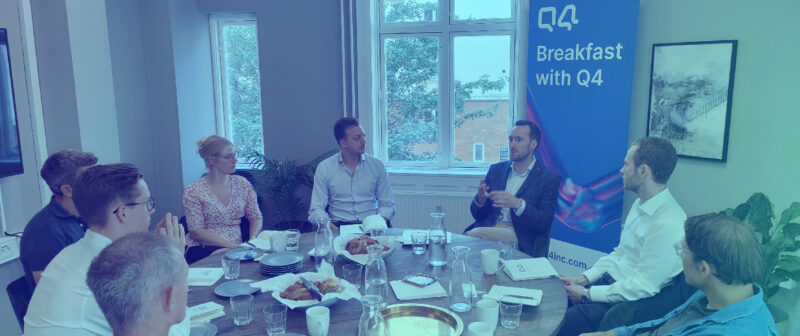Our recent breakfast event brought together professionals from Copenhagen’s investor relations (IR) industry to discuss the evolving landscape of investor relations events. The attendees from around Europe and the Nordics discussed seven main points throughout the event, exploring the need for adaptation, customisation, and strategic planning in investor relations events. From industry-specific approaches to engaging target audiences and utilising data-driven insights, these takeaways shed light on the path forward for successful IR events.
- The Need for Adaptation: The IR industry, often prescriptive in its practices, must adapt to the changing needs of companies and investors. There is no one-size-fits-all solution, emphasising the importance of tailoring events to the specific industry and company requirements.
- Targeting Retail Investors and Small Caps: In markets with limited activity, such as Copenhagen, companies with low liquidity and limited free float (small caps) face the challenge of effectively engaging retail investors, including high-net-worth individuals and family offices. These companies must find ways to target and cater to retail investors in the secondary market. Conversely, large caps may focus on minimising risk and staying competitive within their peer group.
- Planning for Success: Investor events should go beyond financial results presentations and incorporate the flow of information, operational updates, and strategy changes throughout a company’s development. A repeatable and scalable communications plan ensures strategic planning for the content rollout throughout the event and the financial year. Collaboration between Marketing and IR teams – especially in larger organisations – is essential to execute a coordinated strategy. Smaller companies often possess greater agility in implementing such plans.
- Understanding the Target Audience: Traditional results calls primarily cater to analysts and institutional investors in Europe and the Nordics. However, it is essential to reconsider the event format to enhance interaction and engagement. Institutional investors often expect a different forum, such as in-person lunches at brokerages. The event format should be tailored to the specific needs of the company and its target audience.
- Aligning with Company Culture: Considering the culture and identity of a company is crucial when designing and executing investor events. For example, a results event for a startup may embrace an informal and DIY approach, with the CEO wearing a t-shirt. Prioritising expenditures to create returns for investors, such as through new hires, takes precedence over high-quality production. Furthermore, newcomers to the capital markets can challenge traditional event formats, recognising that outdated practices may not reflect how information is consumed in modern times.
- Large Caps vs Small Caps: Paradoxically, large caps often have more substantial budgets but are less innovative and more risk-averse. For results events, larger companies may employ a production crew to enhance the event’s quality, emphasising salesmanship and crafting the message. However, cost constraints often limit such investments. Small caps, on the other hand, can be more agile and innovative. Often, we see large caps following the lead of smaller companies in adopting alternative event formats, such as recording short CEO updates on an iPhone or engaging with online communities through Q&A sessions on investor portals.
- Harnessing Investor Updates: Capital Market Days (CMDs) are often avoided due to concerns about reception and potential negative impacts on share price performance. However, when approached with a clear purpose, CMDs can provide great opportunities to capitalise on the momentum, provide strategic updates, and offer investors access to highly-qualified leaders and industry experts. CMDs should only be held when relevant, and careful consideration should be given to the participants, including external resources and subsidiary company CEOs.
The insights from our breakfast event highlight the need for the IR industry to adapt and customise its approach to investor relations events. By recognising the importance of industry and company-specific strategies, planning for success, understanding the target audience, aligning with company culture, and harnessing data-driven insights, IR teams can elevate the effectiveness of their events. Whether embracing agility and innovation in small caps or finding ways to balance production value with budget constraints in large caps, there are opportunities for every company to enhance their investor communication. By reimagining investor relations events and embracing change, companies can forge stronger connections with investors, drive engagement, and ultimately achieve their business objectives.
For more information on what was discussed at the breakfast event and the evolving landscape of investor relations events, book a meeting with a Q4 rep!


